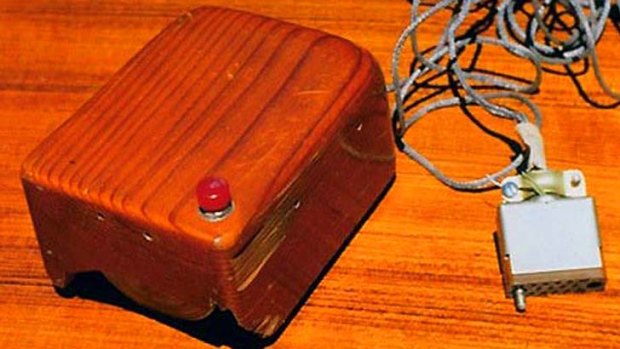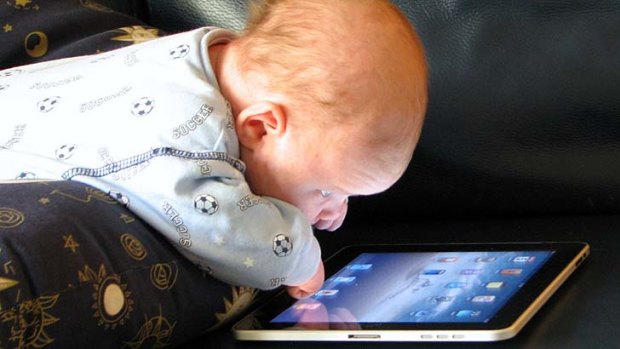Swipe, swipe, pinch-zoom. Fifth-grader Josephine Nguyen is researching the definition of an adverb on her iPad and her fingers are flying across the screen.
Her 20 classmates are hunched over their own tablets doing the same. Conspicuously absent from this modern scene of high-tech learning: a mouse.

The first mouse, made out of wood, was built in 1963.
Nguyen, who is 10, said she has used one before — once — but the clunky desktop computer/monitor/keyboard/mouse setup was too much for her.
"It was slow," she recalled, "and there were too many pieces."

The mouse will be foreign to kids growing up with iPhones and iPads.
Gilbert Vasquez, 6, is also baffled by the idea of an external pointing device named after a rodent.
"I don't know what that is," he said with a shrug.
Nguyen and Vasquez, who attend public schools in San Jose, California, are part of the first generation growing up with a computer interface that is vastly different from the one the world has gotten used to since the dawn of the personal-computer era in the 1980s.
This US autumn, for the first time, sales of iPads are cannibalising sales of PCs in schools, according to Charles Wolf, an analyst for the investment research firm Needham & Co. And a growing number of even more sophisticated technologies for communicating with your computer — such as the Leap Motion boxes and Sony Vaio laptops that read hand motions, as well as voice recognition services such as Apple's Siri — are beginning to make headway in the commercial market.
John Underkoffler, a former MIT researcher who was the adviser for the high-tech wizardry that Tom Cruise used in Minority Report, says that the transition is inevitable and that it will happen in as soon as a few years.
Underkoffler, chief scientist for Oblong, a Los Angeles-based company that has created a gesture-controlled interface for computer systems, said that for decades the mouse was the primary bridge to the virtual world — and that it was not always optimal.
"Human hands and voice, if you use them in the digital world in the same way as the physical world, are incredibly expressive," he said. "If you let the plastic chunk that is a mouse drop away, you will be able to transmit information between you and machines in a very different, high-bandwidth way."
This type of thinking is turning industrial product design on its head. Instead of focusing on a single device to access technology, innovators are expanding their horizons to gizmos that respond to body motions, the voice, fingers, eyes and even thoughts. Some devices can be accessed by multiple people at the same time.
Keyboards might still be used for writing a letter, but designing, say, a landscaped garden might be more easily done with a digital pen, as would studying a map of Lisbon by hand gestures, or searching the internet for Rihanna's latest hits by voice. And the mouse — which many agree was a genius creation in its time — may end up as a relic in a museum.
The first computer mouse, built at the Stanford Research Institute in Palo Alto, Calif., by Douglas Englebart and Bill English in 1963, was just a block of wood fashioned with two wheels. It was just one of a number of interfaces the team experimented with. There were also foot pedals, head-pointing devices and knee-mounted joysticks.
But the mouse proved to be the fastest and most accurate, and with the backing of Apple founder Steve Jobs — who bundled it with shipments of Lisa, the predecessor to the Macintosh, in the 1980s — the device suddenly became a mainstream phenomenon.
Englebart's daughter, Christina, a cultural anthropologist, said that her father was able to predict many trends in technology over the years, but she said the one thing he has been surprised about is that the mouse has lasted as long as it has.
"He never assumed the mouse would be it," said the younger Englebart, who wrote her father's biography. "He always figured there would be newer ways of exploring a computer."
She was 8 years old when her father invented the mouse. Now 57, she says she is finally seeing glimpses of the next stage of computing with the surging popularity of the iPad. These days her two children, 20 and 23, do not use a mouse anymore.
San Antonio and LUCHA elementary schools in eastern San Jose, just 17 miles south of where Englebart conducted his research, provide a glimpse at the future. The schools, which share a campus, have integrated iPod Touches and iPads into the curriculum for all 700 students. The teachers all get Mac Airbooks with touch pads.
"Most children here have never seen a computer mouse," said Hannah Tenpas, 24, a kindergarten teacher at San Antonio.
Kindergartners, as young as 4, use the iPod Touch to learn letter sounds. The older students use iPads to research historical information and prepare multimedia slide-show presentations about school rules. The intuitive touch-screen interface has allowed the school to introduce children to computers at an age that would have been impossible in the past, said San Antonio Elementary's principal, Jason Sorich.
Even toddlers are able manipulate a touch screen. A popular YouTube video shows a baby trying to swipe the pages of a fashion magazine that she assumes is a broken iPad.
"For my one-year-old daughter, a magazine is an iPad that does not work. It will remain so for her whole life," the creator of the video says in a slide at the end of the clip.
"The popularity of iPads and other tablets is changing how society interacts with information," said Aniket Kittur, an assistant professor at the Human-Computer Interaction Institute at Carnegie Mellon University. ". . . Direct manipulation with our fingers, rather than mediated through a keyboard/mouse, is intuitive and easy for children to grasp."
Underkoffler said that while desktop computers helped activate the language and abstract-thinking parts of a child's brain, new interfaces are helping open the spatial part.
"Once our user interface can start to talk to us that way . . . we sort of blow the barn doors off how we learn," he said.
That may explain why iPads are becoming so popular in schools. Apple said in July that the iPad outsold the Mac 2 to 1 for the second consecutive quarter in the education market. In all, the company sold 17 million iPads in the April-to-June quarter; at the same time, mouse sales in the United States are down, some manufacturers say.
"The adoption rate of iPad in education is something I'd never seen from any technology product in history," Apple chief executive Tim Cook said in July.
At San Antonio Elementary and LUCHA, which started their $US300,000 iPad and iPod experiment last school year, the school board president, Esau Herrera, said he is thrilled by the results. Test scores have gone up (although officials say they cannot directly correlate that to the new technology), and the level of engagement has increased.
The schools are now debating what to do with the handful of legacy desktop PCs, each with its own keyboard and mouse, and whether they should bother teaching students to move a pointer around a monitor.
"Things are moving so fast," said LUCHA Principal Kristin Burt, "that we're not sure the computer and mouse will even be around when they get old enough to really use them."
The Washington Post